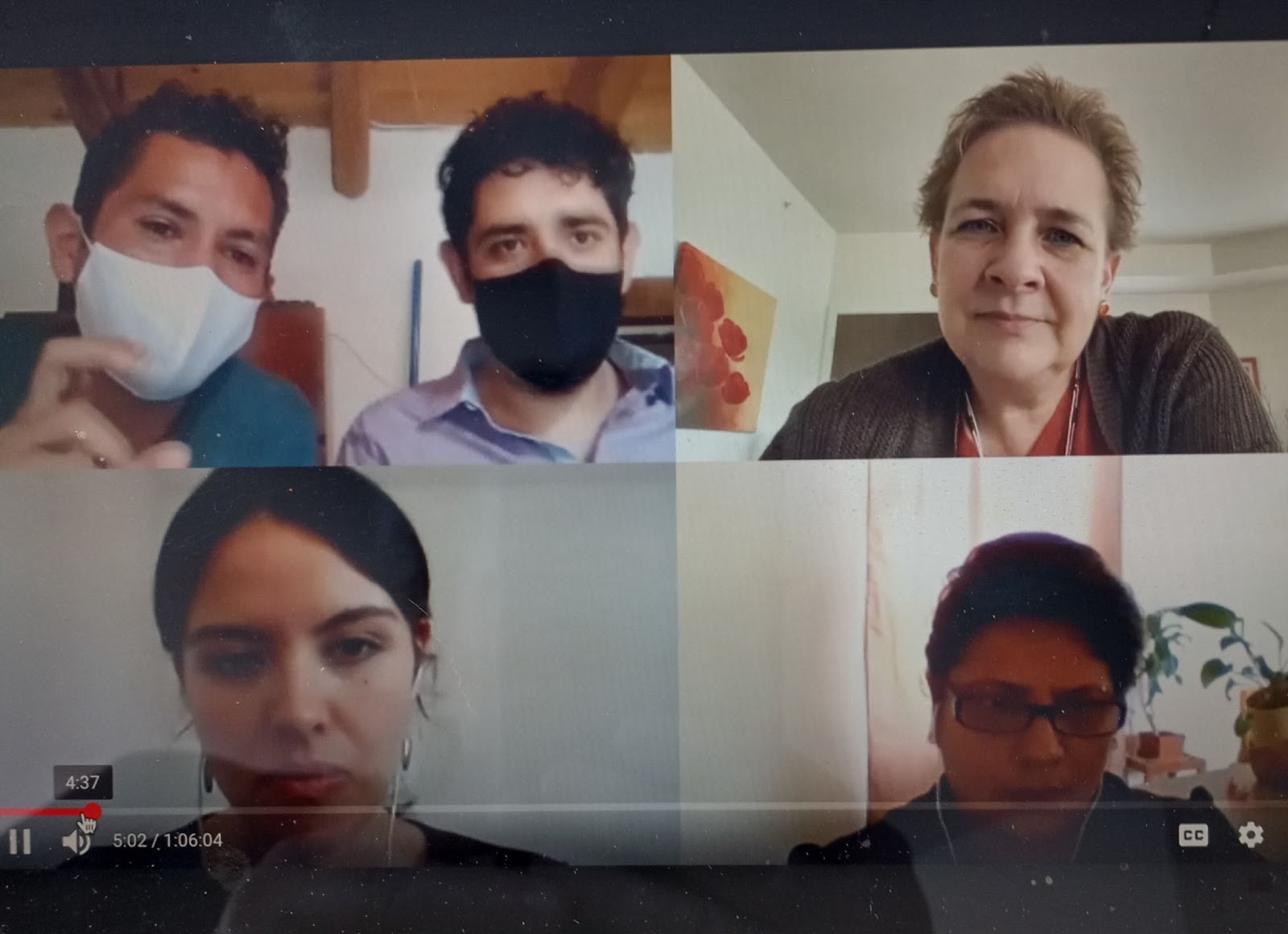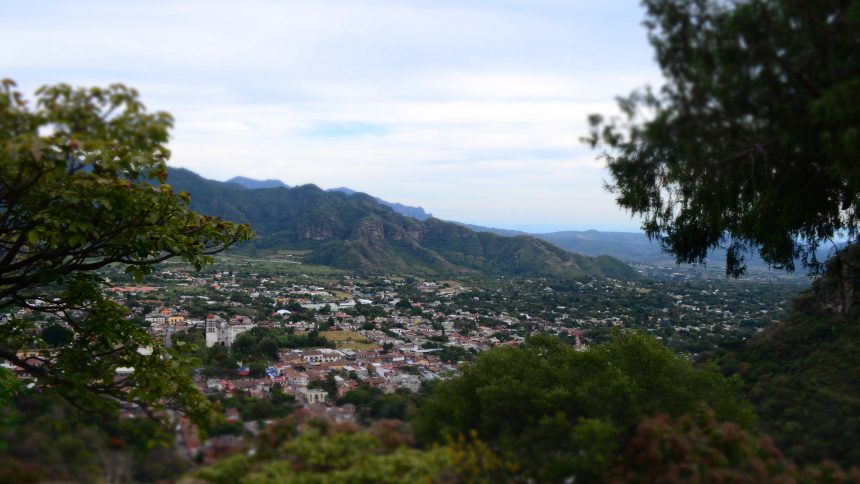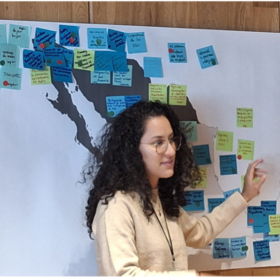This blog post was written by Lisa Schalla, Project Director of the Connecting Communities in the Americas initiative. Este blog está escrito por Lisa Schalla, directora de la iniciative Conectando Comunidades en América. Para leer el texto en español, aquí.
On June 1st, I had the opportunity to interview the team at Fundación Comunitaria Malinalco, a CCA grantee for an action project with migrant communities in their municipality. Here are some of the highlights with the Executive Director Yazmín Miranda and her team: María Carmen Ortega, Jalil Guadarrama and Luis Tetatzin.

What does “consolidating citizen participation” mean, as part of FC Malinalco’s mission?
Carmen – There are many groups that are already very active, but they work separately, independent of each other. We bring in the opportunity to promote citizen participation for the common good.
Yazmín – It’s important that this participation comes naturally from the people and their interest to improve a situation
How do you see your role as a community foundation in this process?
Jalil – In Malinalco people are already very active and there are many groups organized at different levels. Through our vision and methodology, we’ve been able to bring some of these groups together and contribute to the growth and stability of these organizations or grassroots groups.
Yazmín – We view FCM as an agent, a place from which these communities can leverage the processes that they are already developing. We are like an umbrella where they are able to come and find new tools for sustainability.
What type of methodology for community engagement have you adopted?
Yazmín – Our methodology is essentially based on grassroots development and strengthening capacities in people, but first we need to know where they are going. That is why participative methods are so important – finding out what people’s perspectives are. We go side-by-side with the population in the coordination of initial mapping, execution of plans, monitoring and evaluation. We work with each community or project for about one year to help build capacities and evaluate their progress.
Carmen – A lot of it has been experiences of trial and error, allowing us to continue adjusting our work – not a defined model, but more like steps to follow. It begins with participative mapping, so that our team can assess how well our vision matches with that of the community. This allows us to be more flexible as we design projects. We listen to people talk about their necessities, their abilities and resources, their desire to work with FCM. I don’t think it’s bad to recognize our errors – they lead us to new practices.
Jalil – If we look at it from a scientific standpoint for our program of strengthening nonprofits, it is based on ethnography and social units. We use mapping to highlight socio-cultural and environmental patterns within the municipality. Then we can use this information with the nonprofits and grassroots groups for professional development.
Yazmín – Yes, important though is that our model of intervention depends on them and within our three areas of work, which are migration, women as small-scale producers and the culture of forestry.
How do you choose which communities to work with?
Yazmín – This has been really interesting in our case. At first, FCM went out into the communities in order to establish connections and now many approach us. It’s been a process of transformation where those who have worked with us pass the word onto other communities.
Carmen – A lot of it has been because of the collaboration we were able to have in two very unfortunate events – the earthquake (of 2017) and now with the pandemic. We’ve tried to view it from a positive standpoint, being able to come closer with our communities. People needed someone to lean on. In one case, several groups of young people wanted to start food drives and came to ask us if they could use our spaces. This was a validation of all the previous work we had done with them – they were organizing themselves but then coming to us for support. So we listened, offered our shoulders to lean on, and supported their efforts. Those were opportunities that opened up for us.
Yazmín – Also, after doing the initial mapping of communities in our areas of work, the foundation makes the calls for proposals to engage the population more closely, and those who have already participated with us often pass on the word to the next generations.
Jalil – The foundation has been able to find leaders and groups that want to work together, so over the years we have already identified many communities.
Yazmín – Yes, through the local leaders we’ve been able to engage with larger population groups. It’s probably been easier in Malinalco than in other places because of our smaller size – to go in, do mapping together, establish relationships, share interests and visions all help us to engage in a much more strategic way with larger groups.
How do you identify community leaders to work with?
Yazmín – There are many types of leaders. We can often identify some of them during the mapping process.
Luis – Some examples are from the environmental brigades, the ejidatarios (communal land assembly members), and mayordomos (sacristens) of the Catholic church. Women also play an important role in leadership, as they are largely responsible for education, catechism classes, run small businesses, attend meetings and motivate the participation of other women. So the participation of women is very important in the communities. With any type of leader we are very careful not to mix with personal interests and maintain a formal line of communication and work with them.
Jalil – Yes, we identify and then approach them, but always to see to what extent we will be able to work with them.
How do you build trust with a new community?
Carmen – It starts with building empathy. They are part of our community – even if we live at a distance from each other, we are all part of the same community.
Luis – Yes, and with identity. We are all part of Malinalco. We know each other, we are brothers and sisters, you know? I know you and therefore I trust you.
Jalil – Knowledge about the socio-cultural context is fundamental. We need to get in there and read, get to know, live it, feel it, take on this identity of Malinalco in order to have effective communication. This has helped to open a lot of doors.
Yazmín – Our previous work has helped too, to forge these relationships and give visibility to the foundation. So that they know we are not just another institution with our own interests, but rather have many years working with communities.
Una fundación comunitaria de México habla de la promoción de la participación comunitaria
El día primero de junio tuve la oportunidad de entrevistar al equipo de la Fundación Comunitaria Malinalco, actualmente beneficiario de CCA para trabajar con comunidades con alta migración del municipio. A continuación, la conversación con Yazmín Miranda, Directora Ejecutiva, y su equipo: María Carmen Ortega, Jalil Guadarrama y Luis Tetatzin.
¿En su misión, qué significa “consolidar la participación ciudadana” para la FC Malinalco?
Carmen – Aquí en Malinalco existen muchos grupos por separado que trabajan de manera participativa, y lo que queremos es la participación ciudadana por un bien común.
Yazmin – Esta participación tiene que nacer de la gente, de su interés para mejorar una situación.
¿Cuál es el papel de la fundación comunitaria en este proceso?
Jalil – En Malinalco existe mucha participación ciudadana, hay muchos grupos organizados. FCM mediante su visión y metodología ha logrado consolidar varios grupos. Ha aportado en cómo sentar su organización de mejor manera.
Yazmin – FCM sirve como potenciador, un parte aguas para poder potenciar todos estos procesos que de las mismas comunidades emergen. En la fundación se han encontrado estos paraguas en los cuales encuentran las herramientas para lograr esta sustentabilidad.
¿Qué metodologías han adoptado para el desarrollo comunitario?
Yazmín – La metodología está basada en el desarrollo de base, fortalecimiento de las capacidades de las personas. Primero tenemos que conocer cuáles son las demandas, por esto los métodos participativos. Saber cuál es la perspectiva de las personas… Vamos a la mano con la población de manera coordinada los diagnósticos, la ejecución de planes, el monitoreo y la evaluación. No solamente de las capacitaciones que damos, sino damos acompañamiento, trabajamos con cada comunidad aprox. un año.
Carmen – Ha sido la experiencia de la prueba y el error, la cual nos ha permitido ir adecuando… no con un nombre definido sino como pasos a seguir. Empezamos con un diagnóstico participativo – ya con unas líneas dirigidas, con metas y resultados, para que nosotros como equipo podemos identificar si nuestra visión concuerda con la de la comunidad. Esto nos permite ser flexibles en armar un proyecto. Necesitamos escuchar a las personas desde sus necesidades, sus capacidades, sus ganas de trabajar con la FCM. No veo mal hablar de los errores..los errores nos permiten encontrar nuevas prácticas;
Jalil – Para el programa de fortalecimiento ( de las OSC), si lo vemos desde el punto de vista científico, partimos desde la etnografía y unidades sociales… se use la cartografía, el mapeo, para darle ordenamiento – para sacar los patrones socio-culturales y ambientales en el municipio; lo que sigue es usar la información junto con las OSC o grupos de base; potencializarlas y fortalecerlas mediante las capacitaciones, con aprox. un año de acompañamiento, hasta que se van consolidando y andan solos.
Yazmin – Es importante tomar en cuenta que el modelo de intervención depende de ellos.
¿Cómo escogen las comunidades con quién van a trabajar?
Yazmin – Ha sido muy interesante en el caso de la fundación. Inicialmente, FCM iba a las comunidades, estableciendo los vínculos. Ahora ya se acercan a la FCM… ha habido un proceso de transformación. Las que ya trabajaron con nosotros han replicado este mensaje a las demás comunidades.
Carmen – En gran parte tiene que ver con colaborar en las situaciones desafortunadas del sismo y la pandemia durante los últimos 4 a 5 años. Tratamos de verlo del lado positivo con el acercamiento con la comunidad… nos permitió ver que tan importante eramos dentro del municipio. La gente necesitaba alguien sobre quién cargarse… se organizaron varios colectivos de chicos para armar una atención de acopio y nos pidieron espacio en la fundación; … era la validación de la fundación. Los jóvenes, fueron ellos que se movieron y nos dieron un reconocimiento por el hecho de estar allí. Nos dimos cuenta que nos empezaron a buscar, entonces nosotros ofrecimos escucharlos, ser un poco su hombro, para apoyar lo que están haciendo… somos personas como ellos y nos abrió esta oportunidad.
Yazmìn – Después de los diagnósticos, la fundación saca sus convocatorias para acercarse a la población. La población que ya ha participado va siendo portavoz para las siguientes generaciones que quieren involucrarse con nosotros.
Jalil – La fundación ha logrado acercarse con líderes, delegados, y grupos que quieren aportar… ya tenemos identificadas las comunidades… es por medio de esto que intervenimos.
Yazmin – A través de líderes, hemos podido entrar a grupos enteros. Ha sido más fácil aquí en Malinalco por ser un lugar más chico, el poder entrar y mapear… en Malinalco todo se conoce. Establecer estas relaciones y compartir estos intereses y visiones permite que podamos acercarnos de manera más estratégica a los grupos grandes.
¿Cómo identifican los líderes de una comunidad?
Yazmìn – Hay muchísimos tipos de líderes… durante el diagnóstico, identificamos muchos de los líderes.
Luis – Líderes de brigadas, ejidales, mayordomos… Las mujeres toman un papel importante en el liderazgo – en la educación, el catecismo, el manejo de negocios chico… ellas acuden a asambleas y mueven a las demás mujeres. La cuestión participativa de la mujer es muy importante en las comunidades. De manera más formal son los delegados y los ejidatarios… lo que nosotros hacemos es identificarlos y trabajar con la gente que ellos mueven. Tenemos el cuidado de no mezclarlo con otros intereses y mantenemos una línea muy lateral para vincularnos con ellos
Jalil – Sí, se acude con ellos, para ver hasta dónde pueden trabajar sin intereses (personales o políticos).
¿Cómo construyen la confianza con la comunidad?
Carmen – A partir de la empatía… son parte de nuestra comunidad, aunque sean lejos, son parte de la misma comunidad.
Luis – La identidad … Somos parte de Malinalco, nos conocemos, somos hermanos… te conozco entonces tengo esta confianza.
Jalil – El conocimiento del contexto socio-cultural del lugar es fundamental. Nosotros necesitamos empaparnos, leer, conocer, vivir, sentir, y apropiarnos de esta identidad malinalquense… para tener la comunicación adecuada… esta parte nos ha abierto muchísimas puertas.
Yazmin – Mucho viene del trabajo previo – el dar a conocer la fundación, que no somos una organización más del gobierno con interesas, sino ya tenemos tiempo trabajando en la comunidad.





